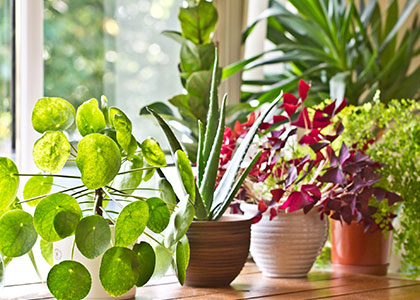
9 Plants that Cleanse the Home
By Isabel Smith, MS, RD, CDN
A clean home is likely one of the things that most of us strive for (or at least it’s definitely higher up on my list of to-do’s!), but a clean home can mean more than just how clean you keep the bathrooms and kitchen. A clean home means that there are few chemical toxins both on the surfaces, and in the air.
When we think of a clean home we often think of things put away nicely, a bathroom that’s been cleaned and maybe the kitchen too, but there are other things that constitute a clean home, and one of those other things is the air quality.
Living in an apartment in New York City can be a real struggle when it comes to keeping the air clean. Whether it’s living next to someone who smokes, or simply because there’s a build up of black soot on my window sill (nearly everyone who lives in New York grapples with this), I’m always trying to get the air in my apartment as clean as possible.
I’ve exhausted the air filters (I own two in a one-bedroom apartment!), I’ve closed the vents to the upstairs construction site, and I clean my window sills at least a few times weekly. So what’s next? Plants.
I’ve forgotten that green plants actually do a nice job of helping to promote clean air inside (and out), and different plants help to lessen presence of various different air pollutants. Common air pollutants include carbon monoxide from fuel emissions, second hand smoke, formaldehyde, benzene, trichloroethylene and ammonia to name a few. There are certain chemicals that are emitted from household functions like furnaces and cars, but there are others that are emitted from household cleaners (check out greener ways to clean your home.
9 Plants that Promote Clean Air in Your Home:
English Ivy
English Ivy is a plant that does well in small spaces and doesn’t require too much light. The great thing about English Ivy is that it’s good at absorbing formaldehyde – a chemical pollutant that can often end up in the air in our homes due to things like chemicals in floor cleaning solutions.
Lady Palm
Lady Palm is a taller plant, and is great because it can absorb ammonia from the air – a chemical pollutant given off from textiles and carpets. Lady palm plants don’t require too much tender care, although they typically grow fairly large. They like moderate watering and some light, and they grow best in 60-80 degree (Fahrenheit) temperatures.
Boston Fern
The Boston Fern is a popular indoor house plant (and is often referred to as an air filter) because it can be put into hanging baskets and doesn’t take up too much space. The downside of the Boston Fern is that it does require humidity and moisture for survival, so this one might be better for someone with a more seasoned green-thumb. Boston Fern is great because it is particularly good at absorbing formaldehyde, that can be found in floor polishes, textiles and more.
Snake Plant
This green plant also does well in low-light situations and is great because it absorbs carbon dioxide and emits oxygen. It’s also good at absorbing formaldehyde from the air too. This plant is relatively easier to grow than some of the others, like the Boston Fern.
Golden Pothos
Golden Pothos is another easier-to-grow plant and it absorbs slightly different chemical pollutants than some of the other plants, including carbon monoxide and benzene. Generally, it’s recommended to put this plant closer to the front door of the house or near the garage where there is likely to be more exhaust from cars and other vehicles entering the house.
Red-Edged Dracaena
This house plant can be a larger one and in some cases its leaves can reach up to 15 feet tall. It requires just a little more sunlight and water than some others.
Aloe Plant
The aloe plant is one that you may have heard of to help you soothe burns on your skin, and it may also help to promote anti-inflammation in the digestive system too. Another wonderful benefit that you may not have heard of is that aloe plants may also help to cleanse the air in the house removing chemical toxins in the air, and when the toxins in the air get to be too much there may actually appear brown spots on the leaves as well.
Rubber Plant
The rubber plant has a funny name but it certainly has a good function. These plants emit more oxygen than some other house plants (that’s clean air into your home), and also helps to pull out chemicals like formaldehyde from the air. This plant is fairly easy to grow because it requires less watering than some others, and also doesn’t require direct light.
Christmas Trees
Although these types of plants don’t typically have wonderful cleansing properties like some of those listed before, adding green plants into the home in general can help to promote a calming, and natural aura that can help to promote de-stressing and relaxation as well. So for that reason, they can help us to cleanse ourselves a little, a process that is even better in our own homes.
Note: It’s key to examine risks of all house plants for children and pets, as some contain chemicals that may be harmful if touched or ingested.